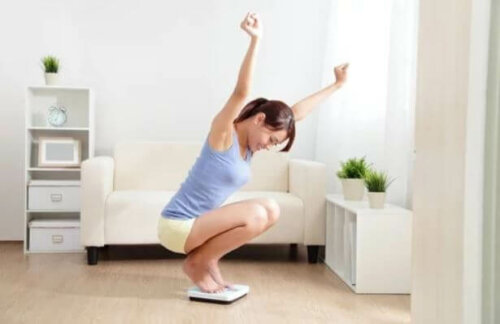Benefits of HIIT Exercises

The boom and popularity currently helping the fitness world to thrive haven’t turned a blind eye towards High-Intensity Interval Training – also known as HIIT exercises.
These exercises provide many benefits for our bodies when we do them properly. However, it’s important to bear in mind that they’re not suitable exercises for everyone.
As one of the most attractive and surprising aspects, 15 minutes of HIIT burns more calories than 30 minutes of running.
As an additional bonus, after those 15 tough minutes, our bodies increasingly benefit from the fat-burning effect over 24 hours.
In essence, these kinds of high-intensity exercises force our bodies to reorganize their metabolisms. It makes the body store fatty acids as a source of energy instead of carbohydrates. If we don’t do this type of activity often, our bodies will use the latter as an energy source.
In case you still have doubts about this, the American College of Sports itself testified in its 2011 annual meeting to the benefits of HIIT. At the same time, it also clarified that two weeks of routinely doing HIIT exercises equaled – more or less – between six and eight weeks of resistance training.

Concrete benefits of HIIT exercises
We’ve already mentioned that this training is less calorific and more functional. But HIIT exercises also increase the functionality of our growth hormone by 450 percent. This is during the first 24 hours after training.
This hormone is in charge of increasing the number of calories we burn and slowing down the aging process. According to the latter, HITT should be a kind of ‘fountain of youth’ that keeps us young inside and out.
If you habitually work on your fitness, you’ve probably already realized that one of the most complicated aspects is finding the middle ground. This is between losing weight but not losing muscle along with it. Unfortunately, this is what happens when we focus mainly on cardiovascular exercises.
As a solution to this, HIIT exercises give us the perfect formula. They allow us to burn up to three times more fat without losing any muscle mass.

According to studies conducted by Little y Gibala in 2006, doing a HIIT workout significantly improves our overall cardiac ability.
In the same study, those that have done this type of training were able to pedal twice as much whilst maintaining a steady heartbeat, compared to those who did more common exercises.
As with many aerobic activities, HIIT workouts are suitable for people suffering from diabetes, by helping to increase glucose consumption and improve insulin sensitivity.
Additional benefits
Although we’ve spoken about highly rewarding but tough training, it’s always possible to adapt it to your physical abilities.
So, by personalizing and combining exercises in a way that suits us, we can find a routine of HIIT exercises that are suitable for beginners and people that don’t work out very often.
And if this wasn’t enough, to do these kinds of routines, you only need to sweat, get tired, and work out enough to exhaust yourself.
You don’t need to waste money on a gym membership or buying specific equipment since you can practice HIIT exercises easily at home or outside.
When HIIT exercises aren’t recommended
It’s not all plain sailing when training with high-intensity exercises. Of course, HIIT exercises come with a series of contraindications (reasons why you should be wary when training). Some contraindications recommend against it and we should keep those in mind.
First of all, if you’re following a low-calorie diet, specialists recommend against this kind of practice, since it can make you dizzy and even lose consciousness due to a lack of glycogen in the body.
Our joints and tendons may suffer an increased workload with this kind of high-intensity training. Those that have any kind of joint or muscle problem should avoid running the risk of hurting themselves badly.

If you’re concerned about whether HIIT exercises are suitable for you, it’s best to visit a health professional – a personal trainer if possible. Personal trainers will be able to advise you about the risks and possible advantages of HIIT for you.
If your cardiovascular system isn’t used to physical exercise, you should avoid HIIT, at least to start with.
Your introduction to working out should be through soft exercises, helping to achieve a better physical capacity. This is essential when approaching more intense training.
Finally, bear in mind that HIIT exercises can cause a rise in blood pressure. Specialists don’t recommend them for people with cardiac or cardiovascular illnesses (especially arterial hypertension).
The boom and popularity currently helping the fitness world to thrive haven’t turned a blind eye towards High-Intensity Interval Training – also known as HIIT exercises.
These exercises provide many benefits for our bodies when we do them properly. However, it’s important to bear in mind that they’re not suitable exercises for everyone.
As one of the most attractive and surprising aspects, 15 minutes of HIIT burns more calories than 30 minutes of running.
As an additional bonus, after those 15 tough minutes, our bodies increasingly benefit from the fat-burning effect over 24 hours.
In essence, these kinds of high-intensity exercises force our bodies to reorganize their metabolisms. It makes the body store fatty acids as a source of energy instead of carbohydrates. If we don’t do this type of activity often, our bodies will use the latter as an energy source.
In case you still have doubts about this, the American College of Sports itself testified in its 2011 annual meeting to the benefits of HIIT. At the same time, it also clarified that two weeks of routinely doing HIIT exercises equaled – more or less – between six and eight weeks of resistance training.

Concrete benefits of HIIT exercises
We’ve already mentioned that this training is less calorific and more functional. But HIIT exercises also increase the functionality of our growth hormone by 450 percent. This is during the first 24 hours after training.
This hormone is in charge of increasing the number of calories we burn and slowing down the aging process. According to the latter, HITT should be a kind of ‘fountain of youth’ that keeps us young inside and out.
If you habitually work on your fitness, you’ve probably already realized that one of the most complicated aspects is finding the middle ground. This is between losing weight but not losing muscle along with it. Unfortunately, this is what happens when we focus mainly on cardiovascular exercises.
As a solution to this, HIIT exercises give us the perfect formula. They allow us to burn up to three times more fat without losing any muscle mass.

According to studies conducted by Little y Gibala in 2006, doing a HIIT workout significantly improves our overall cardiac ability.
In the same study, those that have done this type of training were able to pedal twice as much whilst maintaining a steady heartbeat, compared to those who did more common exercises.
As with many aerobic activities, HIIT workouts are suitable for people suffering from diabetes, by helping to increase glucose consumption and improve insulin sensitivity.
Additional benefits
Although we’ve spoken about highly rewarding but tough training, it’s always possible to adapt it to your physical abilities.
So, by personalizing and combining exercises in a way that suits us, we can find a routine of HIIT exercises that are suitable for beginners and people that don’t work out very often.
And if this wasn’t enough, to do these kinds of routines, you only need to sweat, get tired, and work out enough to exhaust yourself.
You don’t need to waste money on a gym membership or buying specific equipment since you can practice HIIT exercises easily at home or outside.
When HIIT exercises aren’t recommended
It’s not all plain sailing when training with high-intensity exercises. Of course, HIIT exercises come with a series of contraindications (reasons why you should be wary when training). Some contraindications recommend against it and we should keep those in mind.
First of all, if you’re following a low-calorie diet, specialists recommend against this kind of practice, since it can make you dizzy and even lose consciousness due to a lack of glycogen in the body.
Our joints and tendons may suffer an increased workload with this kind of high-intensity training. Those that have any kind of joint or muscle problem should avoid running the risk of hurting themselves badly.

If you’re concerned about whether HIIT exercises are suitable for you, it’s best to visit a health professional – a personal trainer if possible. Personal trainers will be able to advise you about the risks and possible advantages of HIIT for you.
If your cardiovascular system isn’t used to physical exercise, you should avoid HIIT, at least to start with.
Your introduction to working out should be through soft exercises, helping to achieve a better physical capacity. This is essential when approaching more intense training.
Finally, bear in mind that HIIT exercises can cause a rise in blood pressure. Specialists don’t recommend them for people with cardiac or cardiovascular illnesses (especially arterial hypertension).
This text is provided for informational purposes only and does not replace consultation with a professional. If in doubt, consult your specialist.








